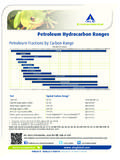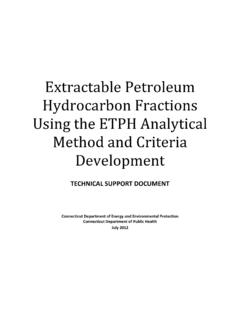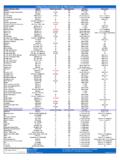Transcription of Petroleum Hydrocarbons Using the EPH/VPH/APH …
1 Petroleum Hydrocarbons Using the EPH/VPH/APH Analytical Methods and Criteria Development TECHNICAL SUPPORT DOCUMENT connecticut Department of Energy and Environmental Protection connecticut Department of Public Health July 2012 EPH/VPH/APH Methods i Contents List of Tables ..ii Background and Analytical Considerations .. 1 Derivation of Remediation Criteria for Petroleum Hydrocarbons .. 4 Toxicity Values .. 4 Calculation of Risk-Based Criteria for Petroleum Hydrocarbons .. 6 Summary of Recommended Criteria Values.
2 9 APPENDICES .. 1 Appendix A .. 1 Appendix B .. 1 Appendix C .. 1 Appendix D .. 1 Appendix E .. 1 Appendix F .. 1 Appendix G .. 1 Appendix H .. 1 EPH/VPH/APH Methods ii List of Tables Table 1 Analytical Methods for Petroleum Hydrocarbons Table 2 Toxicity Values for Use in Deriving Petroleum Hydrocarbons Criteria Using EPH/VPH/APH Methodologies Table 3 Ceiling Values Used in Criteria Derivation Table 4 Analytical Reporting Levels per CT RCP Method Documents Table 5 Summary of Remediation Criteria for Petroleum Hydrocarbons Criteria Using EPH/VPH/APH Methodologies Table C-1 Residential Direct Exposure Criteria Formulas Table C-2 Calculation of
3 Residential Direct Exposure Criteria Table C-3 Industrial/Commercial Direct Exposure Criteria Formulas Table C-4 Calculation of Industrial/Commercial Direct Exposure Criteria Table D-1 Pollutant Mobility Criteria Formulas Table D-2 Calculation of GA Pollutant Mobility Criteria Table D-3 Calculation of GB Pollutant Mobility Criteria Table E-1 Groundwater Protection Criteria Formulas Table E-2 Calculation of Groundwater Protection Criteria Table F-1 Residential Target Indoor Air Concentration Formulas Table F-2 Calculation of Residential Target Indoor Air Concentration Table F-3 Industrial/Commercial Target Indoor Air Concentration Formulas Table F-4 Calculation of Industrial/Commercial Target Indoor Air Concentration Table G-1 Volatilization Criteria Formulas Table G2 Definition of Variables Table G3 Calculated Variables Table G4 Default Input Values Table G-5 Calculation of Residential Groundwater Volatilization Criteria Table G-6 Calculation of Industrial/Commercial Groundwater Volatilization
4 Criteria Table G-7 Calculation of Residential Soil Vapor Volatilization Criteria Table G-8 Calculation of Industrial/Commercial Soil Vapor Volatilization Criteria Table H-1 Calculation of Surface Water Protection Criteria Table H-2 Calculation of connecticut Tier 2 Chronic Aquatic Life Criteria Table H-3 Data Used to Derive Aquatic Life Criteria for Hexane Table H-4 Data Used to Derive Aquatic Life Criteria for Decane Table H-5 Data Used to Derive Aquatic Life Criteria for Cyclododecane EPH/VPH/APH Methods Page 1 of 12 Background and Analytical Considerations The connecticut Remediation Standard Regulations, Sections 22a-133k-1 through 22a-133k-3 of the Regulations of connecticut State Agencies (RSRs), contain environmental criteria to facilitate the assessment and remediation, as necessary, at sites within connecticut which have been affected by releases of various substances.
5 Within the regulations promulgated in 1996, criteria were established for certain individual semi-volatile substances commonly associated with releases of Petroleum hydrocarbon mixtures in addition to criteria for Total Petroleum Hydrocarbons (TPH) as a complex aggregate of substances as reported by the United States Environmental Protection Agency (EPA) Method , which utilized Freon-111. In an effort to help bring about the end of Freon use in connecticut and to be consistent with Federal Law, the connecticut Department of Energy and Environmental Protection (DEEP) stopped accepting analytical data derived by EPA Method for samples collected on or after June 30, 2009.
6 In addition, the Environmental Laboratory Certification Program of the connecticut Department of Public Health stopped offering certification for EPA Method as of September 30, 2009 and after this deadline laboratories may not use EPA Method Since the TPH remediation criteria in the regulations were method specific, and laboratories could no longer use EPA Method , this effectively prevented the use of the promulgated criteria from use at remediation sites for samples collected on or after June 30, 2009.
7 Since 1999, another analytical method has been available for use in connecticut to evaluate Petroleum Hydrocarbons as a complex mixture of aggregate of substances. This method is titled "Analysis of Extractable Total Petroleum Hydrocarbons Using Methylene Chloride Gas Chromatograph/Flame Ionization Detection (ETPH Method)," prepared by the Environmental Research Institute, University of connecticut , dated March 1999 and approved by the Commissioner of the State of connecticut Department of Public Health (CT DPH) on June 22, 1999.
8 Certain remediation criteria Using the ETPH Method were recommended at that time for the Extractable Total Petroleum Hydrocarbons fraction (ETPH) and have been available for use with site-specific approval at remediation sites. The ETPH Method reports ETPH which is different from TPH as reported by EPA Method At this time DEEP intends to propose adoption of remediation criteria based on the ETPH Method into the RSRs. Information regarding the proposed criteria is available in document titled Extractable Petroleum hydrocarbon Fractions Using the ETPH Analytical Method and Criteria Development.
9 Additionally, in 1997, the Massachusetts Department of Environmental Protection (MA DEP) developed risk-based criteria and new analytical methods which focused on quantifying Petroleum Hydrocarbons based on the number of carbon atoms within the hydrocarbon molecule and consideration of whether the fraction was extractable, volatile or in a gaseous phase. These methods, referred to as the Extractable Petroleum hydrocarbon (EPH), Volatile Petroleum hydrocarbon (VPH), and Air-Phase Petroleum hydrocarbon (APH) methods, which address extractable, volatile and air-phase Petroleum hydrocarbon fractions, are also available for use with site-specific approval at remediation sites.
10 The Reasonable Confidence Protocols EPH/VPH/APH Methods Page 2 of 12 (RCPs) for the EPH, VPH and APH methods were finalized in May 2009 and are available on DEEP s website. The connecticut Reasonable Confidence Protocol for the APH method is expected to be released for public comment in the future. Criteria for Petroleum Hydrocarbons are developed to complement the analytical methods used to determine the amount of Petroleum Hydrocarbons present. Since, Petroleum Hydrocarbons are a complex aggregate of substances, the results of Petroleum hydrocarbon analyses differ depending on the analytical method used, with each method targeting a slightly different subset of the full amount of Petroleum Hydrocarbons potentially present.












